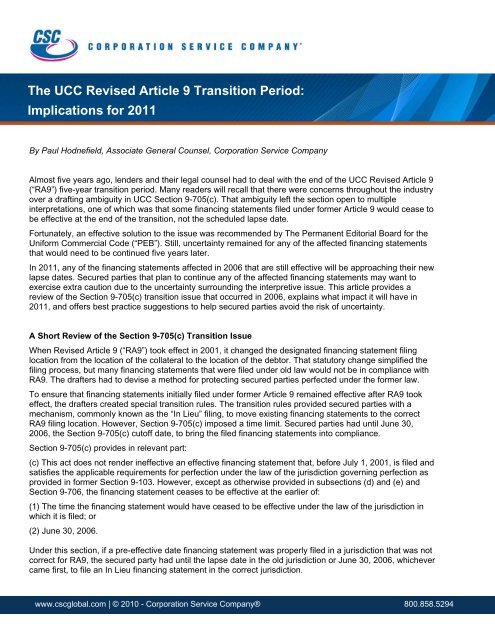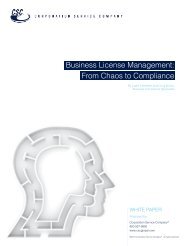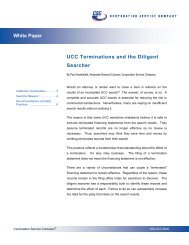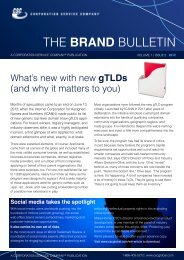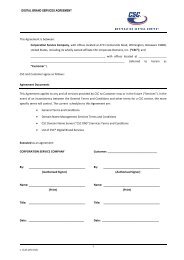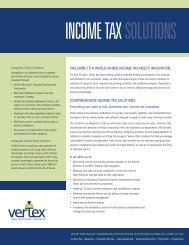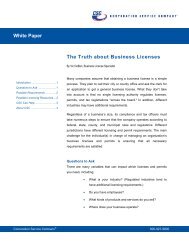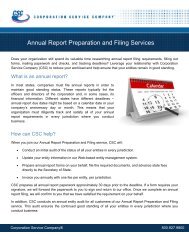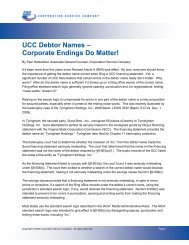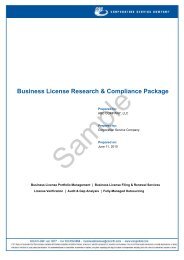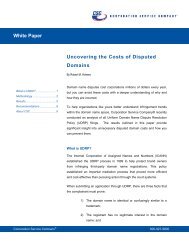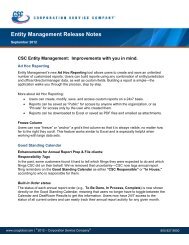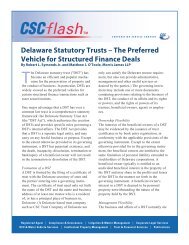The UCC Revised Article 9 Transition Period - Corporation Service ...
The UCC Revised Article 9 Transition Period - Corporation Service ...
The UCC Revised Article 9 Transition Period - Corporation Service ...
You also want an ePaper? Increase the reach of your titles
YUMPU automatically turns print PDFs into web optimized ePapers that Google loves.
<strong>The</strong> <strong>UCC</strong> <strong>Revised</strong> <strong>Article</strong> 9 <strong>Transition</strong> <strong>Period</strong>:<br />
Implications for 2011<br />
By Paul Hodnefield, Associate General Counsel, <strong>Corporation</strong> <strong>Service</strong> Company<br />
Almost five years ago, lenders and their legal counsel had to deal with the end of the <strong>UCC</strong> <strong>Revised</strong> <strong>Article</strong> 9<br />
(“RA9”) five-year transition period. Many readers will recall that there were concerns throughout the industry<br />
over a drafting ambiguity in <strong>UCC</strong> Section 9-705(c). That ambiguity left the section open to multiple<br />
interpretations, one of which was that some financing statements filed under former <strong>Article</strong> 9 would cease to<br />
be effective at the end of the transition, not the scheduled lapse date.<br />
Fortunately, an effective solution to the issue was recommended by <strong>The</strong> Permanent Editorial Board for the<br />
Uniform Commercial Code (“PEB”). Still, uncertainty remained for any of the affected financing statements<br />
that would need to be continued five years later.<br />
In 2011, any of the financing statements affected in 2006 that are still effective will be approaching their new<br />
lapse dates. Secured parties that plan to continue any of the affected financing statements may want to<br />
exercise extra caution due to the uncertainty surrounding the interpretive issue. This article provides a<br />
review of the Section 9-705(c) transition issue that occurred in 2006, explains what impact it will have in<br />
2011, and offers best practice suggestions to help secured parties avoid the risk of uncertainty.<br />
A Short Review of the Section 9-705(c) <strong>Transition</strong> Issue<br />
When <strong>Revised</strong> <strong>Article</strong> 9 (“RA9”) took effect in 2001, it changed the designated financing statement filing<br />
location from the location of the collateral to the location of the debtor. That statutory change simplified the<br />
filing process, but many financing statements that were filed under old law would not be in compliance with<br />
RA9. <strong>The</strong> drafters had to devise a method for protecting secured parties perfected under the former law.<br />
To ensure that financing statements initially filed under former <strong>Article</strong> 9 remained effective after RA9 took<br />
effect, the drafters created special transition rules. <strong>The</strong> transition rules provided secured parties with a<br />
mechanism, commonly known as the “In Lieu” filing, to move existing financing statements to the correct<br />
RA9 filing location. However, Section 9-705(c) imposed a time limit. Secured parties had until June 30,<br />
2006, the Section 9-705(c) cutoff date, to bring the filed financing statements into compliance.<br />
Section 9-705(c) provides in relevant part:<br />
(c) This act does not render ineffective an effective financing statement that, before July 1, 2001, is filed and<br />
satisfies the applicable requirements for perfection under the law of the jurisdiction governing perfection as<br />
provided in former Section 9-103. However, except as otherwise provided in subsections (d) and (e) and<br />
Section 9-706, the financing statement ceases to be effective at the earlier of:<br />
(1) <strong>The</strong> time the financing statement would have ceased to be effective under the law of the jurisdiction in<br />
which it is filed; or<br />
(2) June 30, 2006.<br />
Under this section, if a pre-effective date financing statement was properly filed in a jurisdiction that was not<br />
correct for RA9, the secured party had until the lapse date in the old jurisdiction or June 30, 2006, whichever<br />
came first, to file an In Lieu financing statement in the correct jurisdiction.<br />
www.cscglobal.com | © 2010 - <strong>Corporation</strong> <strong>Service</strong> Company® 800.858.5294
<strong>The</strong> <strong>UCC</strong> <strong>Revised</strong> <strong>Article</strong> 9 <strong>Transition</strong> <strong>Period</strong>:<br />
Implications for 2011<br />
A different section addressed the situation where a pre-effective date financing statement was filed in the<br />
correct office for both former <strong>Article</strong> 9 and RA9. Section 9-705(d) provides that a secured party could<br />
continue the effectiveness of a pre-effective date financing statement that was filed in the correct filing office<br />
under both former <strong>Article</strong> 9 and RA9 simply by filing a continuation statement.<br />
It might appear from reading Section 9-705 as a whole that subsection (c) applied only to pre-effective date<br />
financing statements filed in incorrect filing office for RA9. However, the statutory text does not make that<br />
clear, resulting in the potential for multiple interpretations of Section 9-705(c).<br />
<strong>The</strong> PEB recognized that there was an interpretive issue with Section 9-705(c) in a 2005 report. One<br />
possible interpretation was that Section 9-705(c) applied only to financing statements filed in a filing office<br />
that was correct under old law, but incorrect under RA9. Another reasonable interpretation was that Section<br />
9-705(c) meant exactly what it said –that all pre-effective date financing statements would cease to be<br />
effective on June 30, 2006, unless first brought into compliance with RA9. <strong>The</strong> PEB took no position on<br />
which interpretation was correct.<br />
<strong>The</strong> interpretive issue left secured parties uncertain over what lapse date would apply to a specific category<br />
of financing statements. Those were the financing statements due to lapse between July 1 and December<br />
31, 2001, that were continued during the pre-RA9 portion of the six-month continuation window. Secured<br />
parties could not be certain whether these affected financing statements would cease to be effective on<br />
June 30, 2006, or lapse at the end of the full five-year effective period. It all depended on what interpretation<br />
of Section 9-705(c) applied.<br />
<strong>Revised</strong> <strong>Article</strong> 9 took effect on July 1, 2001. It was a common practice for secured parties to continue<br />
financing statements that were due to lapse between July 1 and December 31, 2001, during the pre-RA9<br />
effective date portion of the six-month continuation window. This practice enabled secured parties to file<br />
under the law they were most comfortable with instead of the new and unknown RA9. Filing continuations<br />
before RA9 took effect made sense at the time, but was to have significant implications for the end of the<br />
transition period.<br />
For example, a financing statement originally filed on October 1, 1996, and continued before the effective<br />
date of RA9 would have received a new lapse date of October 1, 2006. Depending on how a court might<br />
interpret Section 9-705(c), the financing statement might have ceased to be effective on June 30, 2006, not<br />
the lapse date reflected in the filing office records or secured party’s tracking system.<br />
<strong>The</strong> PEB observed that there was a “safe harbor window” during which a secured party could file its<br />
continuation for an affected financing statement and remain perfected regardless of how the courts might<br />
later interpret Section 9-705(c). That safe harbor ran from the opening of the six month continuation window<br />
through June 30, 2006. <strong>The</strong> PEB report advised secured parties to file during that window to avoid the risk<br />
created by different interpretations of Section 9-705(c).<br />
Implications for 2011<br />
Many secured parties followed the PEB recommendations in 2006, but that left another area of uncertainty<br />
for secured parties that will want to continue the affected financing statements again in 2011. Under Section<br />
9-515(e) a continuation statement continues the effectiveness of the initial financing statement for five years<br />
commencing on the day in which the financing statement would have become ineffective in the absence of<br />
the filing.<br />
www.cscglobal.com | © 2010 - <strong>Corporation</strong> <strong>Service</strong> Company® 800.858.5294
<strong>The</strong> <strong>UCC</strong> <strong>Revised</strong> <strong>Article</strong> 9 <strong>Transition</strong> <strong>Period</strong>:<br />
Implications for 2011<br />
<strong>The</strong> potential for different interpretations of Section 9-705(c) still creates uncertainty regarding whether the<br />
affected financing statements will next lapse on June 30, 2011 or the fifth anniversary of the original lapse<br />
date. Assuming Section 9-705(c) applied to all financing statements filed under former <strong>Article</strong> 9, the affected<br />
records could inadvertently lapse on June 30, 2011, instead of the lapse date reflected in the filing office<br />
records or secured parties’ expiration tracking systems<br />
Best Practices<br />
Secured parties that are concerned about the Section 9-705(c) interpretive issue can take action in 2011 to<br />
minimize the risk and eliminate uncertainty. <strong>The</strong> first step is to identify the records subject to the interpretive<br />
issue. Those records consist of financing statements that were:<br />
Originally filed on or before December 31, 1996.<br />
Due to lapse between July 1 and December 31, 2001.<br />
Continued on or before June 30, 2001.<br />
Continued again on or before June 30, 2006.<br />
If an active financing statement meets all these criteria, the secured party simply needs to file its next<br />
continuation statement prior to June 30, 2011. Secured parties should be aware that the filing window may<br />
be less than six months. Filing offices will calculate the beginning of the six-month continuation window<br />
based on the indexed lapse date, not the fifth anniversary of the Section 9-705(c) cutoff date.<br />
Conclusion<br />
<strong>The</strong> good news is that there are very few financing statements still at risk from the Section 9-705(c)<br />
interpretive issue in 2011. Most of the records continued in 2006 have since been terminated or will be<br />
intentionally allowed to lapse. Even those records that the secured party plans to continue in 2011 may not<br />
be at risk. <strong>The</strong> correct interpretation of Section 9-705(c) is still an open question. Nevertheless, secured<br />
parties that want to approach the issue from an abundance of caution should file their continuations for<br />
affected financing statements no later than June 30, 2011.<br />
Secured parties must also be aware that several states enacted legislation to address the issue in 2006, or<br />
had other special circumstances that will require extra diligence. Those states include Arizona, Florida,<br />
Maryland, Texas, and a few others. It is important for any secured party that wants to continue an affected<br />
financing statement to check the applicable state law to determine the best course of action.<br />
Additional Resources on the 2006 <strong>Transition</strong> Issue<br />
2005 PEB Report: http://extranet.ali.org/directory/files/DEC2005PEB-report.pdf<br />
2005 <strong>Article</strong> Remaining Perfected Through the <strong>Revised</strong> <strong>Article</strong> 9 <strong>Transition</strong> <strong>Period</strong>:<br />
http://www.iaca.org/downloads/9-705/REMAININGPERFECTED_042105.pdf<br />
Please feel free to contact Paul Hodnefield, Associate General Counsel for <strong>Corporation</strong> <strong>Service</strong> Company,<br />
with any questions or comments at phodnefi@cscinfo.com, or 800-423-7398.<br />
www.cscglobal.com | © 2010 - <strong>Corporation</strong> <strong>Service</strong> Company® 800.858.5294
<strong>The</strong> <strong>UCC</strong> <strong>Revised</strong> <strong>Article</strong> 9 <strong>Transition</strong> <strong>Period</strong>:<br />
Implications for 2011<br />
www.cscglobal.com | © 2010 - <strong>Corporation</strong> <strong>Service</strong> Company® 800.858.5294


